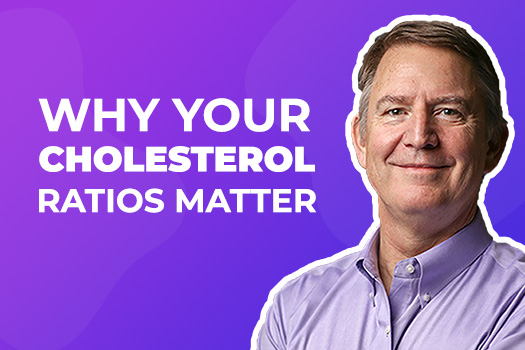Why is it important to understand your cholesterol profile ratios and which ratios are important to look at?
First of all, let’s just go over what a ratio is. A ratio is the division of one number by another. A ratio is a fraction. BMI, for example, is a ratio. It’s your weight (in kilograms) divided by your height (in meters squared). We use ratios all the time. Now in looking at cholesterol, a ratio is really important. Going back to BMI, your height and weight mean different things – if you’re tall and you have a high weight, your BMI is not going to be abnormally reflective of a high fat mass. Someone who’s very short with the same weight is going to have a greater likelihood of being obese with a high BMI. So, BMI adjusts your weight for your height. For cholesterol, there’s a similar need for that, because you’ve heard of “good cholesterol” and you’ve heard of “bad cholesterol.” How do you account for both in one number? You use a ratio.
For years, people have been talking about the total cholesterol, LDL, triglyceride, and HDL as isolated numbers. Well, how do you account for HDL (the “good cholesterol”), when that’s high and your “bad cholesterol” (the total cholesterol, LDL, and triglyceride)? How do you account for that? With a ratio. If you have a lot of good cholesterol, it’s going to outweigh or counteract the bad cholesterol. It’s a simple idea. All of the ratios have HDL – the good cholesterol – as the denominator of the fraction or the ratio to account for the fact that a lot of people have high ‘bad cholesterol’, but they have really good levels of good cholesterol, so you don’t have to worry about that.
We have been led to believe that there is just one good and bad cholesterol, but you don’t ascribe to that, correct?
It’s too simple and it doesn’t account for all the different types of LDLs and the triglyceride, which is the new “bad actor” that most doctors don’t really talk about. In the old way of thinking, having the total cholesterol-to-HDL ratio or the LDL-to-HDL ratio does better in predicting heart disease and strokes than just one of those numbers by itself. It’s not a perfect predictor, but you can account for someone’s increased risk by a high total cholesterol-to-HDL ratio or a high LDL-to-HDL ratio. In the new paradigm of metabolic syndrome, we don’t use total cholesterol and LDL on the top anymore; we use triglyceride on the top divided by HDL (on the bottom). HDL being at the bottom of that fraction is really important for you to understand that your risk is not just the total cholesterol, LDL, or triglyceride number. The main message I get across to my patients is that HDL needs to be in the equation; it needs to be in that ratio.
To reiterate, the new way of understanding cardiovascular risk is by looking at your triglyceride-to HDL-ratio, is that correct?
That’s right. That’s the new understanding, which is called metabolic syndrome. It includes other things beyond the lipids, but yes, it’s the new way.
Is it preferable to have a high HDL-cholesterol and a low triglyceride level?
That’s right. The triglyceride is the fats that are on VLDLs in the blood. You’re going to see the triglyceride and the VLDL track together because triglycerides are carried on the LDLs. Triglycerides, LDLs, and total cholesterol together, are the things in the blood that are associated with atherosclerosis. However, high HDLs are protective and if you look very carefully on the lab tests that you get, there’s a normal range for these things and then the “guidelines.” You’ll see an HDL over 60 mg/dl or so in U.S. units (1.55 mmol/l) is actually protective, yet most doctors don’t account for that HDL in their decision making, because most guidelines aren’t updated with the latest information. You have to have a way to account for that HDL in your risk prediction.
Triglyceride is one of the bad guys in general, so you want to keep triglyceride as low as you can. In our studies, if you get a triglyceride-to-HDL ratio of 1 or 1.5, we think that’s very protective. That doesn’t give you risk for insulin resistance or diabetes. (If your triglycerides are less than double your HDL-cholesterol.) You want to get your triglyceride to HDL ratio as low as you can – 1 to 1. You want to lower the triglyceride number and raise the HDL number in order to get that ratio adjusted. Check out the full video here.
